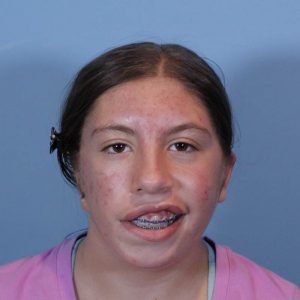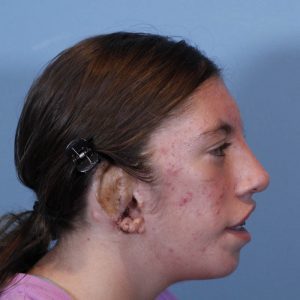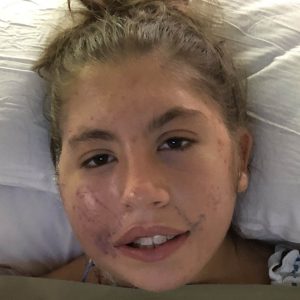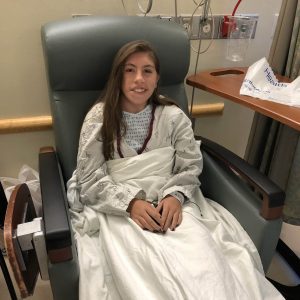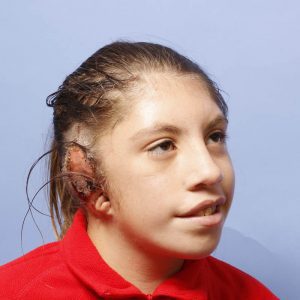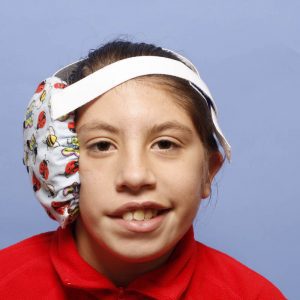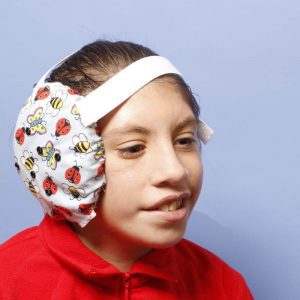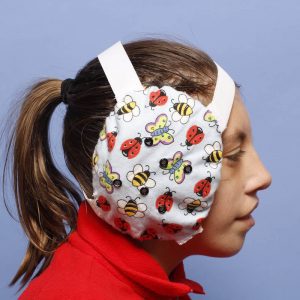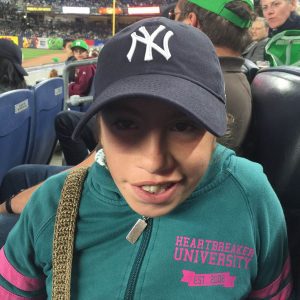
Goldenhar Syndrome is an uncommon congenital condition, occurring one in every 3,000-5,000 births. Also known as oculo-auriculo-vertebral spectrum, Goldenhar Syndrome affects the development of the eye, ear and spine, and sometimes also facial structure and organs such as the heart, lungs, and kidneys.

Goldenhar Syndrome is an uncommon congenital condition, occurring one in every 3,000-5,000 births. Also known as oculo-auriculo-vertebral spectrum, Goldenhar Syndrome affects the development of the eye, ear and spine, and sometimes also facial structure and organs such as the heart, lungs, and kidneys.
What does it look like?
Children born with Goldenhar Syndrome may have partially formed ears or absent ears. The eye, or eyes, may have abnormal growths. Goldenhar Syndrome often is accompanied by hemifacial microsomia, which affects the cheekbones and jaw on one side of the face. Usually, the deformities related to Goldenhar Syndrome only affect one side of the body.
The spine is also affected, often with scoliosis. Sometimes, vertebrae are missing or abnormal. These deformities can be an obstacle for children’s growth and development, as a well as a risk for pulmonary disorders where rib cage deformities are also present.
What causes Goldenhar Syndrome?
Researchers still are not sure what causes Goldenhar Syndrome. It can be passed down through genetics; a child born by a parent with Goldenhar has a 50% chance of having Goldenhar at birth. However, in most cases of Goldenhar Syndrome, there is no family history, so the cause still is quite unknown.
How is it treated?
Each case is treated on an individual basis, taking into careful consideration the child’s unique condition and health challenges. There are many variables involved, so a personalized treatment plan is key. The first step is filling out the form below to see if LBFF can help.
Our priority is always to minimize the stress of treatment for children as much as possible. Depending on the urgency and health risks of your child’s condition, we may delay or avoid surgery if possible. For example, if spinal deformities are hindering your child’s growth or if rib cage deformities threaten respiratory function, these conditions will be treated first.
Facial deformities, tend to be less time-sensitive and can wait until children are older and better prepared to face surgery.
As always, we want you to know that your child will be in the very best care. Not only do we have an incredible staff to guide you through the process, we also have the nation’s leading surgeons armed with the latest technology and scientific research. Take heart. There is a lot that we can do today to treat birth defects like Goldenhar Syndrome
WARNING
Children born with Goldenhar Syndrome may have partially formed ears or absent ears. The eye, or eyes, may have abnormal growths. Goldenhar Syndrome often is accompanied by hemifacial microsomia, which affects the cheekbones and jaw on one side of the face. Usually, the deformities related to Goldenhar Syndrome only affect one side of the body.
The spine is also affected, often with scoliosis. Sometimes, vertebrae are missing or abnormal. These deformities can be an obstacle for children’s growth and development, as a well as a risk for pulmonary disorders where rib cage deformities are also present.
What causes Goldenhar Syndrome?
Researchers still are not sure what causes Goldenhar Syndrome. It can be passed down through genetics; a child born by a parent with Goldenhar has a 50% chance of having Goldenhar at birth. However, in most cases of Goldenhar Syndrome, there is no family history, so the cause still is quite unknown.
How is it treated?
Each case is treated on an individual basis, taking into careful consideration the child’s unique condition and health challenges. There are many variables involved, so a personalized treatment plan is key. The first step is filling out the form below to see if LBFF can help.
Our priority is always to minimize the stress of treatment for children as much as possible. Depending on the urgency and health risks of your child’s condition, we may delay or avoid surgery if possible. For example, if spinal deformities are hindering your child’s growth or if rib cage deformities threaten respiratory function, these conditions will be treated first.
Facial deformities, tend to be less time-sensitive and can wait until children are older and better prepared to face surgery.
As always, we want you to know that your child will be in the very best care. Not only do we have an incredible staff to guide you through the process, we also have the nation’s leading surgeons armed with the latest technology and scientific research. Take heart. There is a lot that we can do today to treat birth defects like Goldenhar Syndrome
WARNING
This gallery contains graphic images that some viewers sensitive to surgery & blood may find disturbing.
What does it look like?
Children born with Goldenhar Syndrome may have partially formed ears or absent ears. The eye, or eyes, may have abnormal growths. Goldenhar Syndrome often is accompanied by hemifacial microsomia, which affects the cheekbones and jaw on one side of the face. Usually, the deformities related to Goldenhar Syndrome only affect one side of the body.
The spine is also affected, often with scoliosis. Sometimes, vertebrae are missing or abnormal. These deformities can be an obstacle for children’s growth and development, as a well as a risk for pulmonary disorders where rib cage deformities are also present.
What causes Goldenhar Syndrome?
Researchers still are not sure what causes Goldenhar Syndrome. It can be passed down through genetics; a child born by a parent with Goldenhar has a 50% chance of having Goldenhar at birth. However, in most cases of Goldenhar Syndrome, there is no family history, so the cause still is quite unknown.
How is it treated?
Each case is treated on an individual basis, taking into careful consideration the child’s unique condition and health challenges. There are many variables involved, so a personalized treatment plan is key. The first step is filling out the form below to see if LBFF can help.
Our priority is always to minimize the stress of treatment for children as much as possible. Depending on the urgency and health risks of your child’s condition, we may delay or avoid surgery if possible. For example, if spinal deformities are hindering your child’s growth or if rib cage deformities threaten respiratory function, these conditions will be treated first.
Facial deformities, tend to be less time-sensitive and can wait until children are older and better prepared to face surgery.
As always, we want you to know that your child will be in the very best care. Not only do we have an incredible staff to guide you through the process, we also have the nation’s leading surgeons armed with the latest technology and scientific research. Take heart. There is a lot that we can do today to treat birth defects like Goldenhar Syndrome
WARNING
Children born with Goldenhar Syndrome may have partially formed ears or absent ears. The eye, or eyes, may have abnormal growths. Goldenhar Syndrome often is accompanied by hemifacial microsomia, which affects the cheekbones and jaw on one side of the face. Usually, the deformities related to Goldenhar Syndrome only affect one side of the body.
The spine is also affected, often with scoliosis. Sometimes, vertebrae are missing or abnormal. These deformities can be an obstacle for children’s growth and development, as a well as a risk for pulmonary disorders where rib cage deformities are also present.
What causes Goldenhar Syndrome?
Researchers still are not sure what causes Goldenhar Syndrome. It can be passed down through genetics; a child born by a parent with Goldenhar has a 50% chance of having Goldenhar at birth. However, in most cases of Goldenhar Syndrome, there is no family history, so the cause still is quite unknown.
How is it treated?
Each case is treated on an individual basis, taking into careful consideration the child’s unique condition and health challenges. There are many variables involved, so a personalized treatment plan is key. The first step is filling out the form below to see if LBFF can help.
Our priority is always to minimize the stress of treatment for children as much as possible. Depending on the urgency and health risks of your child’s condition, we may delay or avoid surgery if possible. For example, if spinal deformities are hindering your child’s growth or if rib cage deformities threaten respiratory function, these conditions will be treated first.
Facial deformities, tend to be less time-sensitive and can wait until children are older and better prepared to face surgery.
As always, we want you to know that your child will be in the very best care. Not only do we have an incredible staff to guide you through the process, we also have the nation’s leading surgeons armed with the latest technology and scientific research. Take heart. There is a lot that we can do today to treat birth defects like Goldenhar Syndrome
WARNING
This gallery contains graphic images that some viewers sensitive to surgery & blood may find disturbing.
If you’re new to this and wondering where to start, please complete the form below so we can get you on the right path. You’re not alone in this, and help is here for you whenever you’re ready.
If you’re new to this and wondering where to start, please complete the form below so we can get you on the right path. You’re not alone in this, and help is here for you whenever you’re ready.
